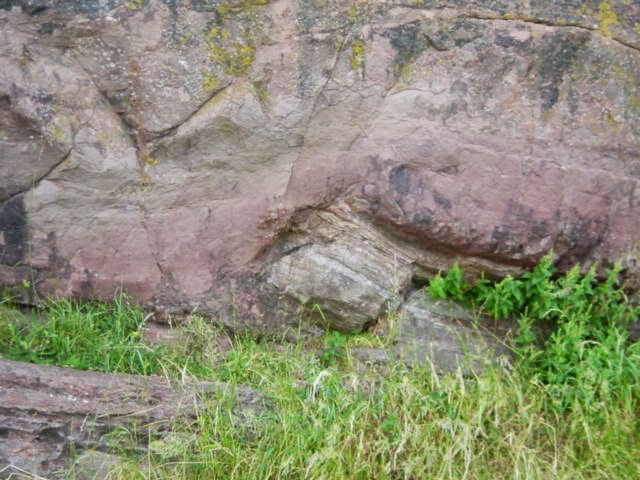Planet Earth - Intrusive & extrusive igneous rocks
There is a famous rock face just below Salisbury Crags in Holyrood Park, Edinburgh.
The rock face tells us about the hot volcanic past in Scotland.
It's called "Hutton's Section" after James Hutton who first noticed it.

The pale layered rock is broken and tilted by the reddish-brown massive rock.
Hutton realised the reddish-brown rock must have been molten magma, pushing with force into the older sedimentary rocks.
This is an example of an intrusion.
The reddish-brown rock is a variety of igneous rock called dolerite.
Edinburgh sits on an ancient volcanic centre.
The volcanic activity happened in the Carboniferous Period.

In this view, Salisbury Crags palisade stands over the city - it is a sill.
On the right is Arthur's Seat, made of four eroded central volcanic vents.
This diagram explains how some volcanic landforms are made.

The rock face tells us about the hot volcanic past in Scotland.
It's called "Hutton's Section" after James Hutton who first noticed it.

The pale layered rock is broken and tilted by the reddish-brown massive rock.
Hutton realised the reddish-brown rock must have been molten magma, pushing with force into the older sedimentary rocks.
This is an example of an intrusion.
The reddish-brown rock is a variety of igneous rock called dolerite.
Edinburgh sits on an ancient volcanic centre.
The volcanic activity happened in the Carboniferous Period.
In this view, Salisbury Crags palisade stands over the city - it is a sill.
On the right is Arthur's Seat, made of four eroded central volcanic vents.
This diagram explains how some volcanic landforms are made.
A sill is one type of igneous intrusion.
Fingal's Cave is on Staffa, an island near Scotland.
The island, like many of the Inner Hebrides, is made of volcanic rock.
In this case the igneous rocks are called 'extrusive', because they formed on the surface.

The vertical lines seen in the photograph were formed when hot lava cooled.
The shrinking basalt lava produced a columnar pattern.
These volcanic rocks date from around 50 to 60 million years ago.
At that time, the North Atlantic was starting to form, with Europe beginning to split from North America.

This diagram shows how volcanoes began to separate Europe and North America 60 million years ago.
Magma from deep in the Earth moved upwards and was erupted at the surface.
Volcanism has continued ever since along a structure called the Mid-Atlantic Ridge.
It created the Atlantic ocean floor and is still pushing the continents steadily apart at a rate of around 2.5 centimetres a year.
In Iceland, this steady volcanism has interacted with a hot mantle plume to create the volcanic island we see today. (Image: © Elizabeth Pickett)
Fingal's Cave is on Staffa, an island near Scotland.
The island, like many of the Inner Hebrides, is made of volcanic rock.
In this case the igneous rocks are called 'extrusive', because they formed on the surface.
The vertical lines seen in the photograph were formed when hot lava cooled.
The shrinking basalt lava produced a columnar pattern.
These volcanic rocks date from around 50 to 60 million years ago.
At that time, the North Atlantic was starting to form, with Europe beginning to split from North America.
This diagram shows how volcanoes began to separate Europe and North America 60 million years ago.
Magma from deep in the Earth moved upwards and was erupted at the surface.
Volcanism has continued ever since along a structure called the Mid-Atlantic Ridge.
It created the Atlantic ocean floor and is still pushing the continents steadily apart at a rate of around 2.5 centimetres a year.
In Iceland, this steady volcanism has interacted with a hot mantle plume to create the volcanic island we see today. (Image: © Elizabeth Pickett)